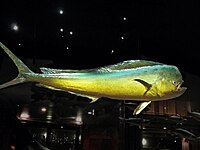
Photo from wikipedia
The Deepwater Horizon (DWH) disaster released 3.19 million barrels of crude oil into the Gulf of Mexico (GOM) in 2010, overlapping the habitat of pelagic fish populations. Using mahi-mahi (Coryphaena… Click to show full abstract
The Deepwater Horizon (DWH) disaster released 3.19 million barrels of crude oil into the Gulf of Mexico (GOM) in 2010, overlapping the habitat of pelagic fish populations. Using mahi-mahi (Coryphaena hippurus)─a highly migratory marine teleost present in the GOM during the spill─as a model species, laboratory experiments demonstrate injuries to physiology and behavior following oil exposure. However, more than a decade postspill, impacts on wild populations remain unknown. To address this gap, we exposed wild mahi-mahi to crude oil or control conditions onboard a research vessel, collected fin clip samples, and tagged them with electronic tags prior to release into the GOM. We demonstrate profound effects on survival and reproduction in the wild. In addition to significant changes in gene expression profiles and predation mortality, we documented altered acceleration and habitat use in the first 8 days oil-exposed individuals were at liberty as well as a cessation of apparent spawning activity for at least 37 days. These data reveal that even a brief and low-dose exposure to crude oil impairs fitness in wild mahi-mahi. These findings offer new perspectives on the lasting impacts of the DWH blowout and provide insight about the impacts of future deep-sea oil spills.
Journal Title: Environmental science & technology
Year Published: 2022
Link to full text (if available)
Share on Social Media: Sign Up to like & get
recommendations!